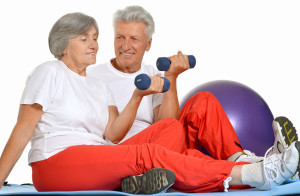Written by Angeline A. De Leon, Staff Writer. A study of 120 community dwelling adults demonstrated the ability of aerobic exercise to increase the size of the brain hippocampus and improve spatial memory.
 The cognitive decline seen in late adulthood can be traced to underlying changes in the brain’s structure over time. Memory impairment, for example, is accompanied by volume shrinkage of the hippocampus 1, with cognitively healthy older adults showing about 1-2% loss in hippocampal tissue every year 2. Counteracting the effects of brain deterioration, aerobic exercise has been found to improve learning and information retention, while increasing cell count 3 and cerebral blood volume 4 in the hippocampus. Such effects have been attributed to the ability of physical activity to enhance the production and secretion of brain-derived neurotrophic factor (BDNF) 5, a group of proteins that work to support neuron development, in the hippocampus. A landmark study by Erickson and colleagues in PNAS (2011) showed that exercise training can successfully be applied to older adults, leading to increased hippocampal volume as well as significant improvements in spatial memory.
The cognitive decline seen in late adulthood can be traced to underlying changes in the brain’s structure over time. Memory impairment, for example, is accompanied by volume shrinkage of the hippocampus 1, with cognitively healthy older adults showing about 1-2% loss in hippocampal tissue every year 2. Counteracting the effects of brain deterioration, aerobic exercise has been found to improve learning and information retention, while increasing cell count 3 and cerebral blood volume 4 in the hippocampus. Such effects have been attributed to the ability of physical activity to enhance the production and secretion of brain-derived neurotrophic factor (BDNF) 5, a group of proteins that work to support neuron development, in the hippocampus. A landmark study by Erickson and colleagues in PNAS (2011) showed that exercise training can successfully be applied to older adults, leading to increased hippocampal volume as well as significant improvements in spatial memory.
In a single-blind, randomized controlled trial, 120 community-dwelling adults completed a 7-week intervention in which they were assigned to participate either in aerobic exercise (n = 60, mean age = 67.6), involving moderate-intense walking three days out of the week, or stretching and toning exercises, which served as a control (n = 60, mean age = 65.5). At baseline and at the 1-year follow-up period, participants were assessed on cardiorespiratory fitness (based on maximal oxygen consumption, VO2 max, on treadmill), memory (using computerized spatial memory task), and hippocampal volume (analyzed from MRI scan). The study provided the following key findings:
Aerobic exercise increases hippocampal volume: Post-intervention, the exercise group showed increased volume of the left and right hippocampus by 2.12% and 1.97%, respectively; controls showed a decrease of 1.40% and 1.43%, respectively. Exercise had a moderating effect on hippocampal volume loss, confirmed by a significant Time x Group interaction for the left [F(2,114) = 8.25; p < 0.001] and right [F(2,114) = 10.41; p < 0.001] hippocampus.
Fitness level is associated with higher hippocampal volume: The exercise group showed a 7.78% improvement in VO2 max, whereas controls showed only a 1.11% improvement. A Time x Group interaction showed this between-group difference to be significant [F(2,111) = 4.42; p < 0.01]. Across both groups, improvements in fitness level were associated with greater increases in hippocampal volume for left (r = 0.37; p < 0.001) and right (r = 0.40; p < 0.001) hemispheres.
Hippocampal volume is related to improved spatial memory: Across all participants, higher levels of aerobic fitness were associated with better spatial memory performance at baseline (r = 0.31; p < 0.001) as well as post-intervention (r = 0.28; p < 0.004). In the exercise group, improvement in memory performance was directly related to increased volume in the left (r = 0.23; p < 0.05) and right (r = 0.29; p < 0.02) hippocampus.
General findings shed light on the malleability of the hippocampus in late adulthood, confirming the capacity of physical activity to effectively protect against age-related deterioration in this region. Aerobic exercise, therefore, represents a promising approach to boosting brain volume and enhancing cognitive functioning in the older adult population.
Source: Erickson KI, Voss MW, Prakash RS, et al. Exercise training increases size of hippocampus and improves memory. Proceedings of the National Academy of the Sciences. 2011; 108(7):3017-3022. DOI: 10.1073/pnas.1015950108.
Click here to read the full text study.
Posted April 10, 2017.
Angeline A. De Leon, MA, graduated from the University of Illinois at Urbana-Champaign in 2010, completing a bachelor’s degree in psychology, with a concentration in neuroscience. She received her master’s degree from The Ohio State University in 2013, where she studied clinical neuroscience within an integrative health program.
References:
- Jack CR, Wiste HJ, Vemuri P, et al. Brain beta-amyloid measures and magnetic resonance imaging atrophy both predict time-to-progression from mild cognitive impairment to Alzheimer’s disease. Brain. 2010;133(11):3336-3348.
- Raz N, Lindenberger U, Rodrigue KM, et al. Regional brain changes in aging healthy adults: general trends, individual differences and modifiers. Cerebral cortex. 2005;15(11):1676-1689.
- Van Praag H, Shubert T, Zhao C, Gage FH. Exercise enhances learning and hippocampal neurogenesis in aged mice. Journal of Neuroscience. 2005;25(38):8680-8685.
- Pereira AC, Huddleston DE, Brickman AM, et al. An in vivo correlate of exercise-induced neurogenesis in the adult dentate gyrus. Proceedings of the National Academy of Sciences. 2007;104(13):5638-5643.
- Vaynman S, Ying Z, Gomez‐Pinilla F. Hippocampal BDNF mediates the efficacy of exercise on synaptic plasticity and cognition. European Journal of Neuroscience. 2004;20(10):2580-2590.
